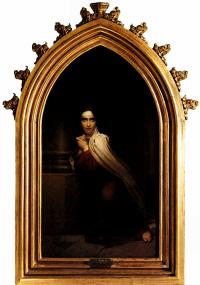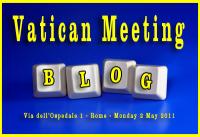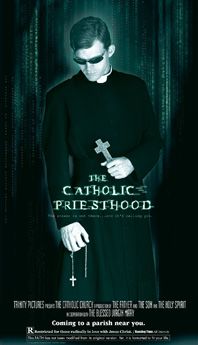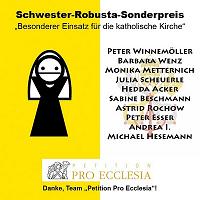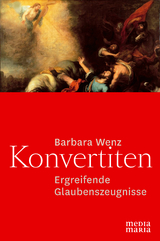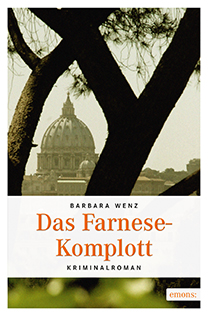[Da es einige Probleme gab, an den Text zu kommen, hier ist er. Pater Lang hat diese Rede auf dem Liturgischen Kongress Anfang September in Sri Lanka gehalten. Die lustig verstreuten Zahlen im Text sollen natürlich Fußnoten sein.]
1. The Liturgical Renewal of Pope Benedict
Millions of people throughout the world saw the present Pope for the first time ever at the funeral Mass of his predecessor John Paul II, at which he presided in his capacity as the Dean of the College of Cardinals. Those who watched this ceremony attentively could not fail to notice the dignity, recollection and genuine affection which he showed in fulfilling this tremendous responsibility. He had the whole world as his stage - literally - but there was not a trace of personal performance. Instead, he communicated something of the spirit of the sacred liturgy, which is an expression of the divine realities that are celebrated in the Church's solemn public worship. Cardinal Ratzinger showed himself a humble and faithful servant of the sacred liturgy at that occasion, and this made it so impressive.1
At this Mass, and at the many public Masses Benedict XVI has already celebrated as Pope, the first essential element of his liturgical "programme" (if we choose to use this word) is evident: setting an example for bishops, priests, deacons, and all the faithful. Pope Benedict seeks a profound renewal of the Church's liturgy above all through his own personal example. In this respect, he follows a long-standing tradition, because, throughout the centuries, Christians from all over the world have looked towards the Church of Rome as a model of the sacred liturgy, sacred music, and sacred art. The liturgical books of the Roman Church were adopted in the Catholic world, and Roman liturgical celebrations provided a model that was imitated in many local churches.
This happened, for instance, in the Carolingian Empire of eighth- and ninth-century Europe, when the early Roman liturgy entered into a fruitful contact and exchange with Germanic and Gallican traditions. It was also an important element of the sixteenth-century Catholic Reform, which had a worldwide impact and initiated the last period in history so far when the Catholic Church was able to shape culture: the Baroque.
The Pope is the first "liturgist" in the Church - not in the sense of a specialist theologian who has studied liturgy and claims expertise in this field, although Joseph Ratzinger's competence in these matters can hardly be doubted. Rather, he is a "liturgist" in the sense of which Saint Paul writes in his Letter to the Romans. The Holy Father commented on this important passage in his homily for the Solemnity of Saints Peter and Paul in 2008: St Paul... expressed the essential of his mission as well as the deepest reason for his desire to go to Rome in chapter 15 of the Letter to the Romans in an extraordinarily beautiful sentence. He knows he is called "to be a minister of Christ Jesus to the Gentiles in the priestly service of the Gospel of God, so that the offering of the Gentiles may be acceptable, sanctified by the Holy Spirit" (15: 16). In this verse alone does Paul use the word "hierourgein" - to administer as a priest - together with "leitourgos" - liturgy: he speaks of the cosmic liturgy in which the human world itself must become worship of God, an oblation in the Holy Spirit. When the world in all its parts has become a liturgy of God, when, in its reality, it has become adoration, then it will have reached its goal and will be safe and sound. This is the ultimate goal of St Paul's apostolic mission as well as of our own mission. The Lord calls us to this ministry. Let us pray at this time that he may help us to carry it out properly, to become true liturgists of Jesus Christ".2
2. The Hermeneutic of Continuity
Benedict XVI wants to emphasize the continuity of liturgical development and so provide an authoritative reading of the post-conciliar reform within the Tradition. It is his profound conviction that the Second Vatican Council must be interpreted in the context of the Church's 2000-year-old history of growth and development, and he explicitly rejects an interpretation of the Council documents as a rupture with the past and proposes a "hermeneutic of reform" or "hermeneutic of continuity". He proposed this reading for the first time in his epochal discourse to the Roman Curia of 22 December 2005, from which I would like to quote the most key passage: The problems in its implementation arose from the fact that two contrary hermeneutics came face to face and quarrelled with each other. One caused confusion, the other, silently but more and more visibly, bore and is bearing fruit.
On the one hand, there is an interpretation that I would call "a hermeneutic of discontinuity and rupture"; it has frequently availed itself of the sympathies of the mass media, and also one trend of modern theology. On the other, there is the "hermeneutic of reform", of renewal in the continuity of the one subject-Church which the Lord has given to us. She is a subject which increases in time and develops, yet always remaining the same, the one subject of the journeying People of God.3
This "hermeneutic of continuity" applies above all to the sacred liturgy. For the Holy Father, this also has a very practical dimension, which is obvious from his own liturgical celebrations, especially since the appointment of Mgr Guido Marini as Papal Master of Ceremonies in September 2007. This includes a number of visible elements, for instance, the wearing of the pontifical dalmatic underneath the chasuble, which expresses the fullness of the Episcopal office, the use of liturgical vestments that follow the classical Roman Baroque style, the characteristic pastoral staff of the popes (the so-called "ferula"), a form of the Pallium that emphasises the continuing tradition of the Church, the use of Cardinal-Deacons assisting the Pope and the chanting of the Gospel also in Greek at solemn occasions, and so on. I shall now comment briefly on a few elements of papal celebrations that are, in fact, intended to be imitated in celebrations of the Catholic liturgy throughout the world.
The Crucifix at the Centre of the Altar
If we want to understand the importance of placing the crucifix on the centre of the altar, we need to ask what the essence of the liturgy is. The Compendium of the Catechism of the Catholic Church provides the following answer : The liturgy is the celebration of the mystery of Christ and in particular his paschal mystery. Through the exercise of the priestly office of Jesus Christ, the liturgy manifests in signs and brings about the sanctification of humankind. The public worship which is due to God is offered by the Mystical Body of Christ, that is, by its head and by its members.4
This key passage takes up an important teaching, which is deeply rooted in the Church's Tradition and has been restated both in Pope Pius XII's encyclical Mediator Dei (1948) and of the Second Vatican Council's Constitution on the Sacred Liturgy Sacrosanctum Concilium (1963): Christ the Eternal High Priest and the Paschal Mystery of his Passion, Death and Resurrection are at the centre of the liturgical action of the Church.5 The Catechism of the Catholic Church also says: "The altar of the New Covenant is the Lord's Cross".6 For this reason, the Cross is intimately linked to the altar where the Holy Eucharist, the sacrifice of the New Covenant, is celebrated. For many centuries, the sign chosen by the Church to orient both mind and body during the liturgy has been the depiction of the Crucified Lord. Thus the cross is the proper focus of liturgical prayer. The centrality of the crucifix on the altar also reminds the faithful that the focus of attention in the Mass is never the priest celebrant, but Christ whose makes himself really, truly and substantially present under the consecrated species of bread and wine.
Communion Received on the Tongue and while Kneeling
The oldest practice of distributing Communion was, according to the early Fathers of the Church, to give Communion to the faithful in the palm of the right hand. However, already towards the end of the Patristic age, the practice of receiving Communion directly on the tongue became more widespread. In fact, virtually all the liturgical rites that can claim an apostolic origin have adopted Communion on the tongue. The reason for this preference is twofold: first, to minimize the dispersion and consequent profanation of Eucharistic fragments; secondly, and more importantly, the increasing devotion of the faithful to the Real Presence of Christ in the sacrament. In fact, even today the norm for receiving Holy Communion is on the tongue, although in many countries the Conferences of Bishops have received the permission of the Holy See that the Sacred Host may also be distributed in the hand of the communicant.7
Over the centuries, the Church has always sought to mark the moment of Holy Communion with the utmost dignity and sacredness. The Sacred Banquet, when Christ gives Himself in the Blessed Sacrament, requires external gestures that will help the faithful to become conscious of this great mystery. Among the signs of Eucharistic devotion, the Latin Church has established the custom to kneel while receiving the Sacred Host. A famous expression of Saint Augustine of Hippo, has been taken up by Benedict XVI in his Post-Synodical Apostolic Exhortation Sacramentum Caritatis: "no one eats that flesh without first adoring it; we should sin were we not to adore it".8 The Holy Father comment : In the Eucharist, the Son of God comes to meet us and desires to become one with us; eucharistic adoration is simply the natural consequence of the eucharistic celebration, which is itself the Church's supreme act of adoration. Receiving the Eucharist means adoring him whom we receive. Only in this way do we become one with him, and are given, as it were, a foretaste of the beauty of the heavenly liturgy.9
The posture of kneeling when receiving Holy Communion expresses and increases the inner attitude of adoration that is absolutely necessary when receiving Christ in the Holy Eucharist. Pope John Paul II wrote in his last encyclical Ecclesia de Eucharistia : By giving the Eucharist the prominence it deserves, and by being careful not to diminish any of its dimensions or demands, we show that we are truly conscious of the greatness of this gift. We are urged to do so by an uninterrupted tradition, which from the first centuries on has found the Christian community ever vigilant in guarding this "treasure". Inspired by love, the Church is anxious to hand on to future generations of Christians, without loss, her faith and teaching with regard to the mystery of the Eucharist. There can be no danger of excess in our care for this mystery, for "in this sacrament is recapitulated the whole mystery of our salvation".10 For these reaons and in keeping with the teachings of his venerated predecessor, Pope Benedict XVI has begun, on the solemnity of Corpus Christi in 2008, to distribute the Body of Christ to the faithful, kneeling and directly on the tongue.
The Use of the Latin Language
Latin was the exclusive language of the Roman Liturgy for many centuries: it has been in use for over sixteen centuries, that is to say, from the time when the official liturgical language of the Roman Church went from Greek to Latin. This process was completed in the late fourth century, in the pontificate of Saint Damasus (+384). The official liturgical books of the Roman Rite are still published in Latin today (editio typica) and then translated into the many languages of the world.
The Fathers of the Second Vatican Council Vatican granted a significant extension of the use of the vernacular in the Catholic liturgy, which had been used in some parts of the liturgy already before. The primary motive for this was to promote "fully conscious and active participation" of the people in the liturgy.': The relevant article of the Constitution on the Sacred Liturgy Sacrosanctum Concilium, no. 36, strikes a balance that was reached after some debate on the Council floor, asserting in the first paragraph that "the use of the Latin language is to be preserved in the Latin rite" (§1), and then, secondly, granting that the use of the vernacular may be extended, which "will apply in the first place to the readings and directives, and to some of the prayers and chants" (§2). Thirdly, "the competent territorial ecclesiastical authority", which ordinarily would be the Conference of Bishops, is to decide "whether, and to what extent, the vernacular language is to be used" (§3). Article 54 of Sacrosanctum Concilium specifies that in "Masses which are celebrated with the people, a suitable place may be allotted to their mother tongue. This is to apply in the first place to the readings and 'the common prayer', but also, as local conditions may warrant, to those parts which pertain to the people". At the same time, however, "steps should be taken so that the faithful may also be able to say or to sing together in Latin those parts of the Ordinary of the Mass which pertain to them".
It is obvious from the relevant articles of Sacrosanctum Concilium that the Fathers of Vatican II did not envisage a general and total replacement of Latin as the liturgical language of the Roman rite with the mother tongue. Even today, the Latin language still holds primacy of place as the liturigical language of the Roman Rite, although most celebrations are in fact held in the vernacular. Even after the liturgical reforms in the wake of the Second Vatican Council, Latin has remained the language of papal liturgies, above all in St Peter's Basilica in the Vatican where normally thousands of pilgrims from all over world gather together. More recently, Benedict XVI has extended the use of Latin in his celebrations as Supreme Pontiff: on his visits outside Rome, Latin is now commonly used for the chants of the Ordinary of the Mass and for the Eucharistic Prayer (that is, from the Preface to the Pater Noster). The reasons for this decision have already been stated by Pope John Paul II in his Apostolic Letter Dominicae cenae:
The Roman Church has special obligations towards Latin, the splendid language of ancient Rome, and she must manifest them whenever the occasion presents itself.12 Likewise, Benedict XVI has called for a greater use of of Latin in the liturgy, especially (but not only) during international gatherings: Speaking more generally, I ask that future priests, from their time in the seminary, receive the preparation needed to understand and to celebrate Mass in Latin, and also to use Latin texts and execute Gregorian chant; nor should we forget that the faithful can be taught to recite the more common prayers in Latin, and also to sing parts of the liturgy to Gregorian chant".13
3. A New Liturgical Movement
In his writings, Joseph Ratzinger has repeatedly spoken about the need for a "new liturgical movement" today. In order to understand better what the present Holy Father means by this, we need to reflect very briefly on the aims of the original Liturgical Movement, which became so influential in the life of the Church during the twentieth century.
The Liturgical Movement can claim as its father the restorer of Benedictine monasticism in France and founder of the Abbey of Solesmes, Dom Prosper Gueranger. In the first volume of his popular work, L 'Annee Liturgique, published in 1845, he appealed to his readers: "Open your hearts, children of the Catholic Church, and come and pray the prayer of your Mother".14 This was to be the essence of the Liturgical Movement: all the faithful should make their own the prayer of the Sacred Liturgy and thus have access to this unique spiritual treasure which was handed on throughout the centuries and enshrined in the official books of the Church.15
A significant moment in the history of the Liturgical Movement was St Pius X's Motu Proprio Tra le sollecitudini of 1903 on the restoration of church music. The fundamental principle of Tra le sollecitudini became the cornerstone of liturgical renewal in the twentieth century : It being our ardent desire to see the true Christian spirit restored in every respect and preserved by all the faithful, we deem it necessary to provide before everything else for the sanctity and dignity of the temple, in which the faithful assemble for the object of acquiring this spirit from its indispensable fount, which is the active participation in the holy mysteries and in the public and solemn prayer of the Church"}6 Why does Benedict XVI see the need for a new liturgical movement in the present moment? The answer to this question may be found in the publications of the Holy Father prior to his election to the See of Peter. In his memoirs, the then-Cardinal Ratzinger wrote: I am convinced that the crisis in the Church that we are experiencing is to a large extent due to the disintegration of the liturgy, which at times has even come to be conceived of etsi Deus non daretur: in that it is a matter of indifference whether or not God exists and whether or not He speaks to us and hears us".17 It is a fact that the Catholic liturgy is not in good shape today - not everywhere, not in every parish, but on balance and in every corner of the world. Benedict XVI is very clear about this in his Letter to the Bishops accompanying the Motu Proprio Summorum Pontificum of 7 July 2007, where, referring to the period immediately following Vatican II, he speaks of "deformations of the liturgy which were hard to bear", and then adds on a personal note: "I am speaking from experience, since I too lived through that period with all its hopes and its confusion. And I have seen how arbitrary deformations of the liturgy caused deep pain to individuals totally rooted in the faith of the Church".18 These words reflect the pastoral care of the Successor of Peter and need to be taken seriously. The present crisis is also reflected in the Instruction Redemptions Sacramentum, on the burning problem of liturgical abuses, issued by the Congregation for Divine Worship and the Discipline of the Sacraments on 25 March 2004.
In the above-quoted passage from his Memoirs, the then-Cardinal Ratzinger concludes that "this is why we need a new Liturgical Movement, which will call to life the real heritage of the Second Vatican Council",1 a claim he takes up again in his important book,The Spirit of the Liturgy, which he hopes will encourage "in a new way, something like a 'Liturgical Movement,' a movement toward the Liturgy and toward the right way of celebrating the Liturgy, inwardly and outwardly."20
What should be the nature of such a "new liturgical movement"? If it is to bring about an authentic renewal, it must first acknowledge that there is a crisis in the liturgical life of the (Latin) Church today and that infelicitous or even erroneous choices have been made in the implementation of Second Vatican Council's norms for a general reform of divine worship, especially the norm of Sacrosanctum Concilium, no. 23 that "there must be no innovations unless the good of the Church genuinely and certainly requires them; and care must be taken that any new forms adopted should in some way grow organically from forms already existing". Secondly, a "new liturgical movement" must be aware of certain ambiguities in the original movement that contributed to this predicament.
What is meant by the attribute "new" in calling for a "new liturgical movement"? Not another surge of human creativity, which is the cause for so many of the liturgical abuses experienced today. Rather, a "new liturgical movement" needs to recover the best elements of the Liturgical Movement, above all its keen awareness of the rite as the "condensed form of living Tradition", as Joseph Ratzinger wrote shortly before his elevation to the See of Peter: The "rite", that form of celebration and prayer which has ripened in the faith and the life of the Church, is a condensed form of living Tradition (...) and thus at the same time the fellowship of generations one with another becomes something we can experience, fellowship with the people who pray before us and after us. Thus the rite is something of benefit which is given to the Church, a living form of paradosis - the handing-on of Tradition.21
In concrete terms, what this means is to reconsider the process of the liturgical renewal desired by Sacrosanctum Concilium according to the hermeneutic of continuity in interpreting the Second Vatican Council, which the Holy Father proposed in his momentous discourse to the Roman Curia on 22 December 2005,22 This is significant also because it overcomes the tendency to "freeze" the present state of the post-conciliar reform in a way that would not do justice to the organic development of the Church's liturgy. An key instance of this hermeneutic of continuity has been provided by Benedict XVI himself in his Motu Proprio Summorum Pontificum by lifting previous restrictions on the use of the pre-conciliar liturgical books and making them the "extraordinary form" or "usus antiquior" of the one Roman Rite. In his Letter accompanying Summorum Pontificum the Holy Father explains his rationale for this: "In the history of the liturgy there is growth and progress, but no rupture. What earlier generations held as sacred, remains sacred and great for us too, and it cannot be all of a sudden entirely forbidden or even considered harmful. It behooves all of us to preserve the riches which have developed in the Church's faith and prayer, and to give them their proper place".23
Footnotes -
1 Cf. the apposite comments of A. Reid, "The Liturgical Reform of Benedict XVI", in N. J. Roy and J. E. Rutherford (eds.) Benedict XVI and the Sacred Liturgy: Proceedings of the First Fota International Liturgy Conference 2008 (Fota Liturgy Series), Dublin: Four Courts Press, 2010, pp. 156-180, at pp. 163-164
2 Benedict XVI, Homily for the Solemnity of Saints Peter and Paul (29 June 2008).
3 Benedict XVI, Christmas Address to the Members of the Roman Curia (22 December 2005).
4 Catechism of the Catholic Church: Compendium, no. 218.
5 Cf. St Thomas Aquinas, Summa Theologiae Ilia q.13 a.2.: "Totus autem ritus christianae religionis derivator a sacerdotio Christ?'.
6 Catechism of the Catholic Church, no. 1182, with reference to Hebrews 13:10.
7 Cf. General Instruction of the Roman Missal, no. 161.
8 St Augustine of Hippo, Enarrationes in Psalmos, 98.9.
9 Benedict XVI, Post-Synodical Apostolic Exhortation Sacramentum Caritatis (22 February 2007), no. 66.
10 John Paul II, Ecclesia de Eucharistia, no. 61. The final quote is from Saint Thomas Aquinas, Summa Theologiae, III, q. 83, a. 4c.
11 Second Vatican Council, Constitution on the Sacred Liturgy Sacrosanctum Concilium (4 December 1963), no. 14.
12 John Paul II, Apostolic Letter Dominicae cenae (24 February 1980), no. 10. b Benedict XVI, Sacramentum Caritatis, n. 62
14 Cited in C. Johnson, Prosper Gueranger (1805-1875): A Liturgical Theologian, Rome: Studia Anselmiana, 1984, p. 350. "Dilatez done vos cceurs, enfants de 1'Eglise catholique, et venez prier de la priere de votre Mere".
15 Cf. on the whole subject A. Reid, The Organic Development of the Liturgy: The Principles of Liturgical Reform and Their Relation to the Twentieth-Century Liturgical Movement Prior to the Second Vatican Council, San Francisco: Ignatius Press, second edition, 2005; O. M. Stamnestra, The Liturgical Reforms of the Second Vatican Council Considered in the Light of the Preceding Liturgical Movement, D.Phil, thesis, Oxford 2007.
16 St. Pius X, Motu Proprio Tra le sollecitudini (22 November 1903).
J. Ratzinger, Milestones: Memoirs 1927-1977, trans. E. Leiva-Merikakis, San Francisco: Ignatius Press, 1998, p. 148.
18 Benedict XVI, Letter to the Bishops that accompanies the Motu Proprio Summorum Pontificum (7 July 2007).
19 Ratzinger, Milestones, p. 148.
20 J. Ratzinger, The Spirit of the Liturgy, trans. J. Saward, San Francisco: Ignatius Press, 2000, pp. 8-9.
21 J. Ratzinger, "Preface", Reid, The Organic Development of the Liturg)>, pp. 9-13, at p. 11.
22 Benedict XVI, Address to the Members of the Roman Curia (22 December 2005); cf. also Sacramentum Caritatis, no. 3.
23 Benedict XVI, Letter to the Bishops.
ElsaLaska - 16. Okt, 13:46

